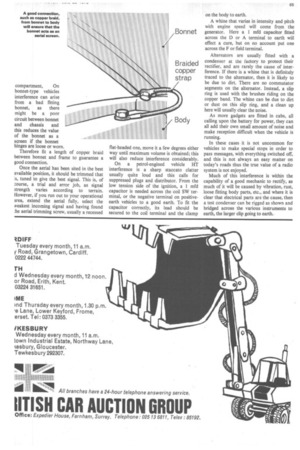road and workshop
Page 66

Page 67

If you've noticed an error in this article please click here to report it so we can fix it.
by Handyman
Suppressing• NT in
on vehicles (1)
ALTHOUGH many transport engineers already have radio equipment added to their responsibilities, there is little doubt that more use would be made of radio control on goods vehicles, were it not for the problems of reception and interference.
These two features, particularly interference, tend to stop potential users from going ahead, yet countless hours can be saved where it is possible for operators to communicate with drivers, or vice versa. While police and ambulance vehicles must be radio equipped of necessity, and have the advantage of technical back-up facilities, other possible users may shy away from the expected problems — poor reception, and maintenance costs.
From experience I have found that the main problem is interference, and it is this aspect rather than the actual radio itself, that I will discuss, since a great deal can be done by the vehicle mechanic to get rid of, or considerably reduce, the nuisance of local interference, so often a lengthy job after installation.
Obviously expert advice is first needed to select the right set for the job, also its correct siting on the vehicle and the right aerial position. Most sets are housed in a metal case which acts as a good screen, provided that it too is properly earthed. However, even though the set works right away, do not rely upon the brackets or stays alone, but fit a short length of +in. copper braid from the case to the steel work of chassis or cab, remove any paint down to bare metal and insert a toothed washer between the braid and the nut or bolt head.
A regular cause of interference is poor siting of the aerial; this can be too near to electrical instruments, particularly on petrol vehicles with HT ignition. Site the aerial aE far away as possible from the vehicle electries, including wipers.
In fixing the aerial, clean carefully anc use a star or toothed washer, also route nu aerial cable clear of the engin( compartment, On bonnet-type vehicles interference can arise from a bad fitting bonnet, as there might be a poor circuit between bonnet and chassis and this reduces the value of the bonnet as a screen if the bonnet hinges are loose or worn.
Therefore fit a length of copper braid between bonnet and frame to guarantee a good connection.
Once the aerial has been sited in the best available position, it should be trimmed that Ls, tuned to give the best signal. This is, of course, a trial and error job, as signal 3trength varies according to terrain. However, if you run out to your operational area, extend the aerial fully, select the weakest incoming signal and having found :he aerial trimming screw, usually a recessed flat-headed one, move it a few degrees either way until maximum volume is obtained; this will also reduce interference considerably.
On a petrol-engined vehicle HT interference is a sharp staccato clatter usually quite loud and this calls for suppressed plugs and distributor. From the low tension side of the ignition, a 1 mfd capacitor is needed across the coil SW terminal, or the negative terminal on positiveearth vehicles to a good earth. To fit the capacitor correctly, its lead should be secured to the coil terminal and the clamp on the body to earth.
A whine that varies in intensity and pitch with engine speed will come from the generator. Here a 1 mfd capacitor fitted across the D or A terminal to earth will effect a cure, but on no account put one across the F or field terminal.
Alternators are usually fitted with a condenser at the factory to protect their rectifier, and are rarely the cause of interference. If there is a whine that is definitely traced to the alternator, then it is likely to be due to dirt. There are no commutator segments on the alternator. Instead, a slip ring is used with the brushes riding on the copper band. The whine can be due to dirt or dust on this slip ring, and a clean up here will usually clear the noise.
As more gadgets are fitted in cabs, all calling upon the battery for power, they can all add their own small amount of noise and make reception difficult when the vehicle is running.
In these cases it is not uncommon for vehicles to make special stops in order to pass messages, with everything switched off, and this is not always an easy matter on today's roads thus the true value of a radio system is not enjoyed.
Much of this interference is within the capability of a good mechanic to rectify, as much of it will be caused by vibration, rust, loose fitting body parts, etc., and where it is clear that electrical parts are the cause, then a test condenser can be rigged as shown and bridged across the various instruments to earth, the larger clip going to earth.




















































































































